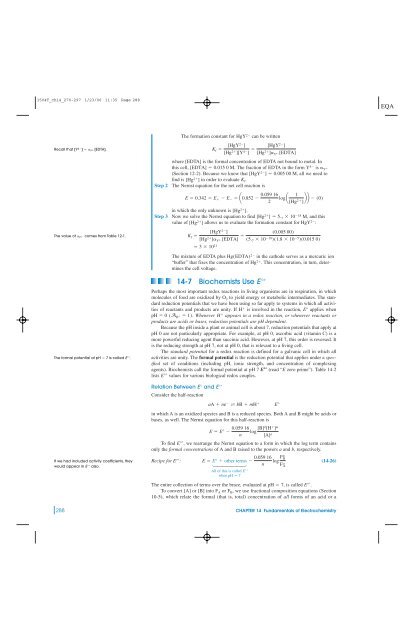Fundamentals of Electrochemistry - W.H. Freeman
Fundamentals of Electrochemistry - W.H. Freeman
Fundamentals of Electrochemistry - W.H. Freeman
Create successful ePaper yourself
Turn your PDF publications into a flip-book with our unique Google optimized e-Paper software.
1504T_ch14_270-297 1/23/06 11:35 Page 288<br />
Recall that [Y 4 ] Y 4 [EDTA].<br />
The value <strong>of</strong> Y 4 comes from Table 12-1.<br />
The formal potential at pH 7 is called E°¿.<br />
If we had included activity coefficients, they<br />
would appear in E°¿ also.<br />
Step 2<br />
The formation constant for HgY 2 can be written<br />
where [EDTA] is the formal concentration <strong>of</strong> EDTA not bound to metal. In<br />
this cell, [EDTA] 0.015 0 M. The fraction <strong>of</strong> EDTA in the form Y 4 is<br />
(Section 12-2). Because we know that [HgY 2 ] 0.005 00 M, all we need to<br />
find is [Hg 2 ] in order to evaluate K f .<br />
The Nernst equation for the net cell reaction is<br />
E 0.342 E E a0.852 <br />
in which the only unknown is [Hg 2 ].<br />
Step 3 Now we solve the Nernst equation to find [Hg 2 ] 5. 7 10 18 M, and this<br />
value <strong>of</strong> [Hg 2 ] allows us to evaluate the formation constant for HgY 2 :<br />
K f <br />
3 10 21<br />
The mixture <strong>of</strong> EDTA plus Hg(EDTA) 2 in the cathode serves as a mercuric ion<br />
“buffer” that fixes the concentration <strong>of</strong> Hg 2 . This concentration, in turn, determines<br />
the cell voltage.<br />
14-7 Biochemists Use E<br />
Perhaps the most important redox reactions in living organisms are in respiration, in which<br />
molecules <strong>of</strong> food are oxidized by O 2 to yield energy or metabolic intermediates. The standard<br />
reduction potentials that we have been using so far apply to systems in which all activities<br />
<strong>of</strong> reactants and products are unity. If H is involved in the reaction, E° applies when<br />
pH 0 (A Whenever H<br />
1). H appears in a redox reaction, or whenever reactants or<br />
products are acids or bases, reduction potentials are pH dependent.<br />
Because the pH inside a plant or animal cell is about 7, reduction potentials that apply at<br />
pH 0 are not particularly appropriate. For example, at pH 0, ascorbic acid (vitamin C) is a<br />
more powerful reducing agent than succinic acid. However, at pH 7, this order is reversed. It<br />
is the reducing strength at pH 7, not at pH 0, that is relevant to a living cell.<br />
The standard potential for a redox reaction is defined for a galvanic cell in which all<br />
activities are unity. The formal potential is the reduction potential that applies under a specified<br />
set <strong>of</strong> conditions (including pH, ionic strength, and concentration <strong>of</strong> complexing<br />
agents). Biochemists call the formal potential at pH 7 E (read “E zero prime”). Table 14-2<br />
lists E°¿ values for various biological redox couples.<br />
Relation Between E and E<br />
Consider the half-reaction<br />
K f [HgY2 ]<br />
[Hg 2 ][Y 4 ] [HgY 2 ]<br />
[Hg 2 ] Y 4[EDTA]<br />
0.059 16<br />
2<br />
1<br />
log a bb (0)<br />
[Hg 2 ]<br />
[HgY 2 ]<br />
[Hg 2 ] Y 4[EDTA] (0.005 00)<br />
(5. 7 10 18 )(1.8 10 5 )(0.015 0)<br />
aA ne T bB mH E°<br />
in which A is an oxidized species and B is a reduced species. Both A and B might be acids or<br />
bases, as well. The Nernst equation for this half-reaction is<br />
0.059 16 [B]<br />
E E° log<br />
[H ] m<br />
n [A] a<br />
To find E°¿, we rearrange the Nernst equation to a form in which the log term contains<br />
only the formal concentrations <strong>of</strong> A and B raised to the powers a and b, respectively.<br />
Recipe for E°¿:<br />
0.059 16 F b B<br />
E E° other terms log<br />
1442443 n F a A<br />
All <strong>of</strong> this is called E°¿<br />
when pH 7<br />
(14-26)<br />
Y<br />
4<br />
The entire collection <strong>of</strong> terms over the brace, evaluated at pH 7, is called E°¿.<br />
To convert [A] or [B] into F A or F B , we use fractional composition equations (Section<br />
10-5), which relate the formal (that is, total) concentration <strong>of</strong> all forms <strong>of</strong> an acid or a<br />
288 CHAPTER 14 <strong>Fundamentals</strong> <strong>of</strong> <strong>Electrochemistry</strong>

















